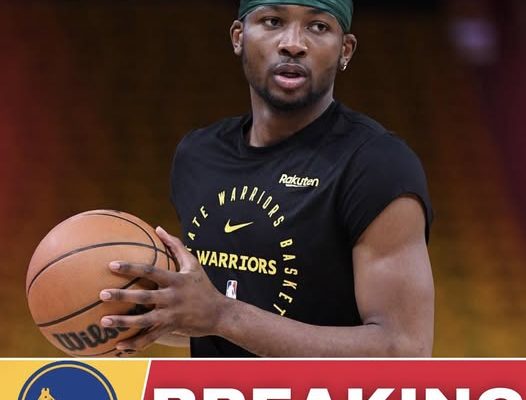Jonathan Kuminga’s decision to reject a 2-year, \$40 million contract extension from the Golden State Warriors has sent shockwaves across the NBA landscape. What initially seemed like a straightforward negotiation between a budding star and a legacy franchise has quickly spiraled into one of the most intriguing offseason developments. For a team that has prided itself on internal development, continuity, and championship culture, Kuminga’s rejection is not just a financial decision—it’s a loud message.
At just 22 years old, Kuminga is entering a critical phase of his young career. Drafted seventh overall in the 2021 NBA Draft, he came into the league with a blend of explosive athleticism, raw talent, and untapped potential. Over the past three seasons, his trajectory has been uneven, in large part due to the Warriors’ reliance on their aging core of Steph Curry, Draymond Green, and Klay Thompson. But when given the opportunity, Kuminga has consistently shown flashes of stardom—flashes that seem to suggest he’s capable of being much more than a rotational player. So when the Warriors presented him with a relatively generous 2-year, \$40 million offer, many assumed he would accept the security and lock in a future with the franchise. He didn’t.
This isn’t a simple bet on future earnings—it’s a calculated stand. For Kuminga, the decision to turn down the extension appears to be rooted in confidence. Confidence that he is worth more. Confidence that he deserves a bigger role. Confidence that his ceiling is higher than what Golden State is currently offering him. And perhaps, confidence that other teams will see it too. From the outside, it’s easy to assume that \$20 million annually is a healthy sum for a player who hasn’t yet been an All-Star or even started consistently for his team. But context matters. The current market for wings with Kuminga’s profile—young, athletic, two-way potential, and capable of guarding multiple positions—is skyrocketing. Players with comparable or even lesser production have secured bigger and longer deals in recent years. Kuminga’s camp knows this. And in declining the offer, they’re sending a signal that they expect his market value to balloon after another breakout year.
On the Warriors’ side, this move puts pressure on the organization to rethink its plans. Golden State is in a precarious position. They are no longer the untouchable juggernaut of the mid-2010s, but they are also not quite ready to blow things up. The franchise is attempting to thread a nearly impossible needle: win now while also building for the future. Players like Kuminga are supposed to be the bridge between those eras. But bridges need to be strong, secure, and confident in their role. Kuminga’s refusal to accept the extension may reflect a lack of clarity about his place in the Warriors’ blueprint.
There have been rumblings over the past two seasons about his dissatisfaction with his minutes and usage. Last season, during stretches when injuries or load management took veterans out of the lineup, Kuminga was thrust into more prominent roles and responded with authority. He averaged career-high numbers across the board, including 16.1 points, 5.2 rebounds, and improved efficiency from the field. He displayed more polish in his offensive decision-making, a better feel for spacing, and greater intensity on defense. In those moments, he didn’t look like a prospect—he looked like a starter. Perhaps even a future star. Yet, when rotations tightened, his minutes were often the first to get chopped.
For a player with high ambitions, that inconsistency isn’t just frustrating—it’s disqualifying. Kuminga’s trajectory is beginning to mirror that of young stars who outgrew their roles in veteran-heavy teams and exploded once they landed in systems that empowered them. The Warriors may see him as a valuable asset, but Kuminga may see himself as a foundational piece. The difference in perception often becomes a breaking point in contract negotiations.
This rejection also raises new questions about the Warriors’ direction. Are they ready to hand the keys to the next generation? Or are they still clinging to the fading brilliance of the dynasty’s original core? They’ve said all the right things publicly—about developing the youth, about bridging eras, about finding balance. But decisions like playing time distribution and extension offers reveal the truth. Kuminga’s rejection suggests he may not see the kind of commitment from Golden State that he desires.
This could also signal potential movement. If Kuminga doesn’t extend this summer and enters the season without a new deal, he becomes a prime candidate for trade talks. Teams across the league are monitoring the situation closely. Young, ascending wings with high athletic upside and three years of NBA experience don’t become available often. Especially not ones who can guard 1-through-4 and still have untapped offensive potential. If Golden State cannot commit to his future, another team will.
His decision may also reverberate throughout the locker room. The Warriors have already made difficult decisions in recent years—trading away Jordan Poole, parting ways with James Wiseman, navigating the Draymond Green and Kevin Durant fallout, and transitioning from GM Bob Myers to Mike Dunleavy Jr. Kuminga’s rejection of this extension may indicate a deeper shift—away from the culture of guaranteed loyalty and toward a more transactional era in Golden State’s management of its young talent.
Meanwhile, Kuminga’s bet on himself is not without risk. If he underperforms or gets injured, the guaranteed \$40 million vanishes. But for a player who believes he can command a \$100 million deal over four years on the open market next summer, the gamble might be worth it. This is a player who’s gone from the G League Ignite straight into the cauldron of championship basketball. He knows what pressure feels like. He knows how to rise to the moment. And right now, the moment is his.
It’s worth noting that Kuminga’s decision doesn’t mean a divorce from Golden State is imminent. Players decline extension offers all the time and still re-sign with their original teams later, sometimes for bigger and longer deals. But it does indicate that Kuminga and his representation believe that his value is higher than what the Warriors offered, and that he has more to gain by waiting. If the Warriors don’t prioritize his development this season—if they continue to give priority to veterans at his expense—then a departure becomes increasingly likely.
In the bigger picture, this also reflects a growing shift in player empowerment, even among young players. Gone are the days when early-career players simply took the first decent offer for the sake of security. Today’s generation is more confident, more strategic, and more vocal. They understand their value not just within their current team but within the broader marketplace of the NBA. Kuminga’s rejection of this offer is a case study in modern player leverage. It’s about control. About future earnings. And about belief.
Warriors fans will undoubtedly be divided. Some will see Kuminga’s move as ungrateful or risky, especially when framed against the backdrop of an illustrious franchise and a generous deal. Others will celebrate his confidence and ambition, recognizing that greatness often requires bold decisions. Regardless of where you stand, it’s impossible to deny that Kuminga has forced the NBA to pay attention.
The next chapter in this story will unfold quickly. Training camp is just around the corner. The Warriors’ rotation will be under a microscope. Every minute Kuminga plays—or doesn’t play—will be scrutinized. Every quote, every rumor, every lineup change will be seen through the lens of this contract standoff. And if Kuminga delivers another leap in performance, as many expect, then the \$40 million number will begin to look like a bargain the Warriors missed out on.
At the end of the day, the NBA is about talent and timing. Jonathan Kuminga believes he has both on his side. He’s not waiting for permission. He’s not settling. And by declining the Warriors’ offer, he’s declared to the basketball world: watch me earn what I’m worth.



